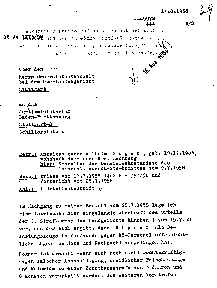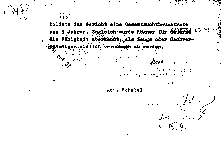From the Records of the Frankfurt Auschwitz Trial, Part 1
How it began…
On March 1, 1958, Adolf Rögner, an inmate in Bruchsal Prison, south-west Germany, filed charges with the Stuttgart prosecutor against one Oberscharführer Wilhelm Boger, who he accused of mistreatment and mass murder of inmates of the concentration camp Auschwitz. In his accusation he pointed out that he was not the only one who could provide witnesses and other evidence:
“[…] at the same time the International Auschwitz Committee, Vienna X, Weigandhof 5, and the Central Council of German Jews, Düsseldorf-Benrath, certainly have complete evidence on hand, and [unreadable] the Concentration Camp Auschwitz Museum has entire volumes and documents, director is the former Polish concentration camp comrade Franz Pargosch, of the Auschwitz Committee Vienna, the principal officer Hermann Langbein is also a former concentration camp man.” (p. 2*)
In a note in the trial records dated May 13, 1958, State Attorney Weber, the prosecutor handling the case, characterized the accuser Rögner as a “glory-seeking psychopath”. (p. 7)
In his “Report on the Interrogation of the Prisoner Adolf Rögner” dated May 6, 1958, court examiner Wasserloos wrote:
“Report on the Interrogation of the Prisoner Adolf Rögner.
Rögner initially gave the impression of a quiet, reasonable man. That impression is quickly dispelled when his repeatedly expressed requests to be shown a photograph of the accused can not be accommodated. To the statement of the undersigned that at this stage of the investigation the provision of a photograph of the accused was not necessary; that, nevertheless, Rögner should try to give the most exact description of the person of the accused, his activities and his criminal behavior, he seemed greatly displeased. He reacted to this in a peculiar way: at first he remained stubborn and gave only short, partly incomplete answers; when he was pressed further, he got more and more excited and changed the subject, mentioned unbearable and degrading conditions in the prison, reviled the officials, particularly the medical personnel, and accused them of mistreating him. This was allegedly being done to silence him, that is allegedly why they let him waste away. He included the public prosecution in his accusations; it allegedly treated him the same way they did in prison; it allegedly uses Gestapo and concentration camp methods and keeps him from protesting, because it allegedly sympathizes with those about whom he had something to say.
After these excesses, Rögner could be brought back to the subject only with difficulty. He responded grudgingly to the questions posed to him, and threatened numerous times that he would have the methods of officials of the Federal Republic denounced in the appropriate place. In connection with this he said he was a man who had been a member of the KPD (Communist Party of Germany) for a long time and would always be a member of it.
His exact knowledge of particular events and localities, which he was able to describe in the minutest detail, was remarkable. Without hesitation he enumerated the mostly four- and five-digit camp numbers of the fellow inmates he spoke about. He completed the drawing included with the transcript without having to think about it. This was quite a contrast to his efforts not to give exact dates. In almost all cases he was unable to answer questions to this end. His comprehensive and detailed knowledge of the operations of the concentration camp Auschwitz are perhaps partially due to the fact that he had considerable relevant data in his possession with which he occupied himself ceaselessly during his imprisonment – as can be verified by the prison administration. He brought several record packets and numerous photographs to the interrogation which pertained to concentration camp Auschwitz, but which were not inspected in order not to draw out the interrogation inordinately, and especially also to have the witness base his statements as much as possible on his own direct knowledge. According to a communication from the prison administration, Rögner carried a number of books on war crimes trials and war crimes experiences with him, which he was no longer allowed to use because his accusations filed against members of the former SS piled up to such a degree that it became apparent that he was probably drawing his facts from his reading, but reported it to the prosecutors as his own knowledge. It was later determined that Rögner maintained a busy correspondence with the International Auschwitz Committee in Vienna. It is not certain that he received material from there regularly. In a recently written letter to the Federal Constitutional Court, Rögner complained that his correspondence with the Auschwitz Committee had been restricted.
The undersigned got the impression from Rögner’s behavior that his entire thinking and striving was directed to busying the prosecutor’s office as much as possible by means of his real or supposed knowledge. He seemed to find satisfaction in this pursuit. He repeatedly declared he would be the star witness in many future criminal trials. The Federal Criminal Office paid particular attention to him: the chief prosecutor of Waldshut had come to him in person since he was to appear as star witness in a trial there in the near future against several SS members. However, it was especially the following statement that is the foundation for the opinion of the undersigned: Rögner responded to the warning that he should concern himself with the truth, that he had no need of the warning. He was far too experienced in these things. He had worked successfully with the American military police for six years as an ‘identifier.’ He said, word-for-word: ‘You should believe me, it was through my testimony that many Nazis have been executed.’
The disposition of the witness, as shown from these statements, matches his character completely; it is not foreign to his personality. The numerous complaints and the various unsupported charges with which Rögner has busied the enforcement and prosecutorial offices recently show this clearly.” (p. 8f.)
On May 9, 1958, the prosecutor in Stuttgart assigned to this case received a letter from the Comité International d’Auschwitz in Vienna, signed by its president Hermann Langbein, with the offer to provide evidence in the matter of the Boger case. Next to Langbein’s leading sentence, “We have been told that you are conducting a case against SS-Oberscharführer Boger”, one of the officials involved in the case noted, “Rögner!” (p. 22a). Apparently in Stuttgart it was known that Rögner had informed Langbein of the charges he had filed and of the consequent interrogation by Wasserloos. Langbein himself later admitted this. (Der Auschwitz-Prozeß, Europäische Verlagsanstalt, Frankfurt/Main 1965, vol. l, p. 21f).
Langbein wrote more letters on May 29, 1958, July 9, 1958, and July 27, 1958 (pp. 31, 34, 36f), in which he demanded that Boger must first be taken into custody before his committee would name witnesses and provide evidence.
In a letter on May 8, 1958, the prison administration in Bruchsal notified the prosecutor in Stuttgart that a case was underway against Rögner for false testimony and perjury committed during a concentration camp trial in Munich (p. 23).
In a letter on April 9, 1958, the prison administration in Bruchsal wrote the chief prosecutor for district I in Munich as follows with respect to the prisoner Rögner: (pp. 24-26)
- Rögner had served a term of imprisonment for fraud and attempted fraud;
- he had been sentenced to imprisonment during the Third Reich for criminal deeds and part of the term was spent in concentration camps;
- he filed “numerous, ungrounded complaints” against authorities, is “quarrelsome”, “eastern oriented” and will emigrate to Poland when he is released, sees himself as a “star witness in a series of great concentration camp trials”;
- he resists official rules, constantly demands exceptions for himself, attempts to use his knowledge of concentration camps to lighten his punishment and pursues “obscure goals”.
On August 14, 1958, prosecutor Schabel wrote to the Baden-Württemberg Minister of Justice concerning the transcript of the decision of the Land Court Munich: (p. 39)
“[…] which shows that Rögner as the prosecution witness in trials against concentration camp personnel has obviously lied for reasons of hatred and revenge.
Rögner was therefore sentenced to a prison term of 3 years and 6 months – although the sentence is not yet valid. […] In addition, Rögner’s right to testify as a witness or expert in a trial has been revoked permanently.”
About Rögner’s testimony
During his interrogation, Rögner answered most questions with “I don’t know”. He could neither describe the accused Boger nor give details as to dates or other circumstances of the supposedly witnessed crimes or proceedings. His exact information on witnesses and other supposed criminals, including their prisoner numbers, can only be explained by his having been supplied with ‘information.’ About a ‘selection’ in Auschwitz he reported as follows:
“Q.: How did you recognize the Jews?
Ans.: By the white badges they wore on their breasts. First, the smallest children were taken out of the goods cars. They were thrown onto a pile. Then they were taken away with two cargo trucks and gassed. Then they took the bigger children out and separated the boys from the girls. Then the women came out, who were divided into two groups. One group went into the camp, the other was taken to the crematories. Finally, they took the men out, and also they were divided into two groups like the women.” (p. 12)
However, if the newly-arriving Jews wore identification, it would have been yellow stars, certainly not white badges. His description of the supposedly witnessed selection is also pure nonsense: the incoming transports were always completely unloaded – the unloading of certain age groups and sexes would have been organizationally impossible. All prisoners were sorted at the same time, not one group after the other. “[T]he smallest children […] were thrown onto a pile”: the world has never seen such humbug! This passage alone shows that professional liar Rögner lied here again!
Wise Insight
With nothing further at hand than the statements of Bernd Naumann in his book Auschwitz (Athenäum, Frankfurt/Main 1968) and the self-testimony of Hermann Langbein, Dr. Wilhelm Stäglich wrote in 1979 in his Auschwitz Mythos (Grabert, Tübingen, p. 297):
“The […] Auschwitz trial developed from an episode which could almost be called banal: On March 1, 1958, a former Auschwitz prisoner named Adolf Rögner, at that time held in the Bruchsal prison, filed charges against former SS Oberscharführer Wilhelm Boger for alleged crimes against humanity committed in concentration camp Auschwitz. […] Langbein […] merely noted that the Auschwitz trial had been ‘initiated due to a fluke.’ […] there are reasons for believing that certain background influences who for various reasons had a great interest in a continuing and expanding pursuit of so-called Nazi mass crimes had spurred Rögner to file charges.”
Stäglich also discusses passages in Rögner’s charge sheet that he considers indicative that Rögner was used by Langbein’s organization. As to any complaint today that Stäglich had speculated wildly, the records of the interrogation show not only that he was correct, but that the case was even worse: Rögner was a Communist, professional denouncer, glory-seeking psychopath, perjured liar, defrauder, saw himself as a “Nazi hunter” and was supplied with literature and information and spurred to file charges by the Auschwitz Committee.
First published in Vierteljahreshefte für freie Geschichtsforschung 6(3) (2002), pp. 343-346. Translated by Michael Humphrey
* All page number refer to: Pubic Prosecution at the District Court Frankfurt (Main), Strafsache beim Schwurgericht Frankfurt (Main) gegen Baer und Andere wegen Mordes, ref. 4 Js 444/59, Vol. I
Bibliographic information about this document: The Revisionist 1(1) (2003), pp. 115-118
Other contributors to this document:
- Michael Humphrey: translation
Editor’s comments: First published in German in "Vierteljahreshefte für freie Geschichtsforschung," 6(3) (2002), pp. 343-346



